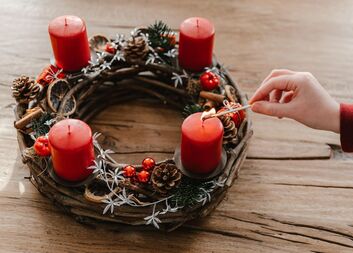The Advent season originates from Christian tradition but is widely celebrated in the Czech Republic. It begins four weeks before Christmas, which is the second most important holiday of the year for Christians.
In modern times, the start of Advent is marked in towns and villages by the festive lighting of a decorated Christmas tree on the first Sunday of Advent. People often make or buy decorated Advent wreaths made of greenery, featuring four candles, which are placed on the family’s festive table. Each Sunday during Advent, an additional candle is lit, so that by the last Sunday before Christmas, all four candles are glowing.
During Advent, Christmas markets are held, where people and families with children can enjoy themselves. These markets offer small Christmas gifts, wooden or textile decorations, sweets to taste, and hot mulled wine or tea to enjoy with friends.
In the Czech Republic, small children receive presents under the Christmas tree from Ježíšek—Baby Jesus (he is not shown, as it is part of the Christmas mystery). In other countries, it is customary for a man, often referred to as Saint Nicholas (Santa Claus or similar), to bring gifts to children.
In Czech tradition, however, the historical figure of Saint Nicholas is associated with a different custom—on the evening before Saint Nicholas Day, December 5th, three characters in costumes visit families with children. They are Saint Nicholas (a bishop in a red robe with a tall hat and a staff), an Angel (in white clothing with a star on their forehead), and a Devil (in a black fur coat with devilish horns). These figures traditionally ask children if they have been good and help their mothers at home. The children are also expected to sing a song or recite a poem. In return, they receive small gifts and sweets from Saint Nicholas.
Christmas in the Czech Republic is celebrated on the evening before the main holiday, December 24th. Families decorate a festive Christmas tree and display nativity scenes (Jesličky or Betlém), made of wood or paper, depicting the story of Jesus’ birth in Bethlehem. A lavish dinner is served, typically featuring fried carp (fish) and potato salad as the main dishes. Families follow various customs depending on their traditions, but carols are always sung or played on the radio and television. Many people, even those who do not regularly attend church, visit the traditional midnight Mass.
December 25th is called Boží hod (Christmas Day), and December 26th is St. Stephen’s Day, during which children used to go caroling in the past. Many people visit churches to see wooden nativity scenes (Betlém). The tradition of crafting wooden nativity scenes is strong in Czech lands, and we recommend visiting the large nativity scene museum in Třebechovice pod Orebem near Hradec Králové. You can watch a video from the museum here.
For school children, the holidays don’t end with Christmas—Christmas break lasts until the New Year (this year, children will return to school on January 6th).

